The Fascinating World of Luxurious Gemstones


Intro
Gemstones have captured the hearts and imaginations of humanity for centuries. Their glittering brilliance and rich histories often intertwine with tales of royalty, ancient civilizations, and cultural significance. When you think of gemstones, the mind might immediately drift to diamonds, sapphires, or perhaps, the lesser-known yet equally captivating tanzanite. However, lurking beneath the surface is a vast world filled with treasures that go beyond mere eye-catching aesthetics. This article aims at shedding light on the most expensive gemstones, diving deeper into their fascinating origins, properties, and the market dynamics that influence their value.
From diamonds that have adorned crowns to the mysterious opal that dances with color, the price tags attached to these precious stones tell stories as rich as the gems themselves. By dissecting the complex factors that dictate their worth—from rarity and demand to their cultural resonance—we paint a comprehensive picture that will intrigue both seasoned collectors and curious novices.
Join us as we explore the allure of these exquisite gems, unveiling the artistry and history that make them stand out in the grand tapestry of Earth's treasures.
History and Origins
Understanding gemstones isn't just about their beauty; it’s also about their journeys through time and culture.
Overview of Collectibles, Rocks, and Fossils
From ancient artifacts to modern collectibles, gemstones have always held a special place in the hearts of collectors. At their essence, gemstones are more than beautiful rocks; they are fragments of history. Each gemstone has a story, encapsulated in its formation over thousands—or even millions— of years.
The development of gemstone collection began long ago. Ancient civilizations, such as the Egyptians and Greeks, coveted these natural marvels for their perceived metaphysical properties. They believed that gems could channel energies and offer protection. As time wore on, the economic significance of gemstones evolved, eventually leading to the luxurious market we see today.
Historical Significance and Cultural Impact
Gemstones have adorned crowns, driven wars, and influenced trade routes. For instance, the Hope Diamond, a rare blue diamond with a tumultuous history, has been the center of intrigue and folklore. This gem's tangled past involves infamous owners and tales of curses, significantly amplifying its worth and allure.
In many cultures, certain gemstones are thought to possess unique properties. In Hinduism, the blue sapphire is not just a gem; it is said to bring prosperity and spiritual insight. The rich lore tied to gemstones continues to captivate, as they are often given as heirlooms, signifying love, luck, and legacy.
"In the world of gemstones, every sparkle carries a whisper of history and a promise of enchantment."
As we dive deeper into the characteristics and significance of specific gemstones, we will uncover the driving forces behind their desirability in today’s market. Understanding these narratives and attributes can substantially enrich one’s appreciation and insight into the intricate dance of supply, demand, and culture surrounding expensive gemstones.
Feel free to delve further into the specific traits of these unique treasures in the following sections.
Prolusion to Precious Gemstones
The world of precious gemstones is a rich tapestry woven with history, value, and intrigue. These remarkable natural occurrences are not only admired for their beauty, but also carry significance across various cultures and eras. This section explores why understanding precious gemstones is crucial, particularly for collectors and enthusiasts who seek to deepen their knowledge of this multifaceted topic.
Definition and Classification
Precious gemstones can be classified based on their mineral composition, rarity, and the cultural perceptions surrounding them. Unlike semi-precious stones, precious gemstones like diamonds, rubies, and emeralds are seen as manifestations of nature's artistry. They are typically more sought after due to their scarcity and superior qualities. Understanding this classification system helps collectors appreciate the unique attributes and specific value of each gemstone built on factors such as:
- Color: The hues and shades that define each type of gemstone, often affecting its perceived value.
- Clarity: The internal characteristics that can contribute to the overall quality.
- Cut: The way a gemstone is fashioned can enhance its natural beauty, making it more appealing.
For collectors venturing into the realm of gemstones, these parameters guide their choices and investment decisions.
Historical Context
The history of precious gemstones is as varied and colorful as the stones themselves. From ancient civilizations adorning their royalty with glittering jewels to modern collectors hunting for one-of-a-kind pieces, gemstones are deeply rooted in human culture. The historical significance of these stones reflects social status, power, and even beliefs. For instance:
- In ancient Egypt, emeralds were associated with fertility and rebirth. They were thought to be favored by Cleopatra, who wore them as a symbol of her wealth and influence.
- During the Middle Ages, rubies were believed to protect their owners from misfortune and harm, often being embedded in armor.
This long-standing relevance shapes today’s market dynamics, where the stories and heritage attached to gemstones influence buying patterns.
"Gemstones have not only captured the public’s eye through their beauty, but their history continues to draw in collectors eager to own a piece of that narrative."
Understanding these historical contexts gives insight into how and why certain gemstones have garnered the prices they do in the current market. With immersive narratives attached to them, collectors can appreciate their potential beyond mere investment, seeing each stone as a slice of history, culture, and artistry.
Understanding Value: Factors That Determine Gemstone Prices
The world of gemstones is intricate, shaped by a multitude of factors that dictate their prices. For collectors and enthusiasts alike, grasping these value determinants is crucial. Understanding how rarity, market demand, and gemstone treatments influence pricing can transform a casual interest into a savvy investment strategy. The allure of gemstones isn't just about their beauty; it's equally rooted in their financial significance. When armed with the right knowledge, collectors can make informed choices, maximizing both aesthetic enjoyment and economic value.
Rarity and Supply
The concept of rarity is foundational in determining the value of a gemstone. When a gemstone is scarce, its price often skyrockets. For instance, consider the case of red diamonds, which are not only stunning but also among the rarest in the world. The limited supply, coupled with the high demand, makes them a jewel sought after by connoisseurs and investors.
On the other side, sapphires are available in a variety of colors, but the rarest hues, like deep blue or padparadscha, command higher prices. The story of a gem’s journey—from its geological formation to the marketplace—also adds to its rarity. For example, stones that originate from a well-known mine, such as the Kashmir sapphire, carry an aura of exclusivity that further drives desirability.
"Rarity is the heartbeat of the gem market; without it, the spark fades."
Understanding how supply chains operate can also shed light on why some gemstones retain their value over time. Fluctuations in mining operations or discoveries of new deposits can impact prices significantly. For serious collectors, tracking these market shifts can be advantageous, helping them catch trends before they become mainstream.
Market Demand
Market demand is another cog in the machinery of gemstone valuation. The preferences of collectors, fashion trends, and cultural significance all shape demand. Take emeralds, for example. Their vibrant green color has won over countless admirers through history, making them a staple in royal jewelry. When celebrities adorn themselves in emeralds, the ripple effect on demand can be felt across the globe.
In recent years, the rise of social media has intensified this dynamic. Instagram influencers showcasing unique jewelry pieces can cause a sudden spike in demand for specific gems, completely distorting previous valuation norms. Such demand can lead to a frenzy over certain rarities, driving prices to astonishing heights.
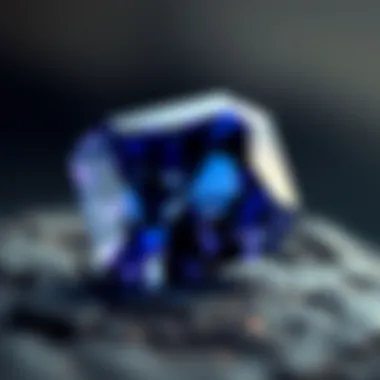
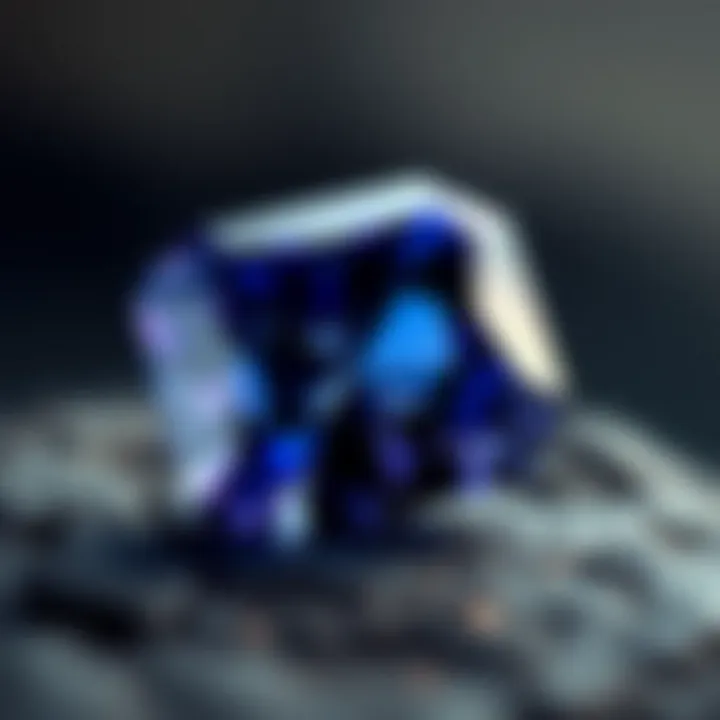
From another angle, the economic climate plays a crucial role in market demand. During prosperous times, luxury goods like high-end gemstones tend to soar in desirability. Conversely, during economic downturns, even the most exquisite pieces might see a dip in perceived value. Understanding these ebbs and flows can provide a clear path through the often turbulent waters of gemstone investments.
Gemstone Treatments and Enhancements
Many gemstones undergo treatments designed to enhance their appearance or durability. This practice can significantly influence a stone’s value, making it a key factor for collectors. For example, while natural rubies can command astronomical prices, those that have been heat-treated—though still valuable—are typically less expensive.
Similarly, diamond clarity treatments can make stones more appealing, but they also raise questions about authenticity and long-term value. Investors need to distinguish between natural and treated stones. A well-informed buyer will consider not just the gemstone's surface appearance but its intrinsic qualities as well. This knowledge is paramount in ensuring that a collection retains its worth over time.
Collectors must also stay abreast of advancements in treatments. As technology evolves, new methods can alter the landscape of gemstone valuation. For instance, lab-grown diamonds have surged in popularity, offering consumers an ethical and often more affordable alternative. Understanding these nuances can aid collectors in discerning true value from mere surface appeal, ensuring they invest wisely in their passion.
Overview of the Most Expensive Gemstones
When we think about gemstones, what often comes to mind are their breathtaking colors and intricate designs. However, their value lies deeper, intertwined with mining processes, rarity, and often a rich tapestry of history. In this article, we explore the world of the most expensive gemstones, shedding light on the dynamics that play a significant role in their valuation. Understanding these factors helps anyone with an interest in gemstones—whether you're a collector or an enthusiast—appreciate the intricacies that contribute to their worth.
Diamonds
When it comes to the most recognized gemstone, diamonds are at the top of the list. Known for their hardness and brilliance, they have captivated humans for centuries.
Types of Diamonds
Diamonds come in various types, each classified based on color, clarity, carat weight, and cut. Colorless diamonds often fetch the highest prices but fancy-colored ones like pink and blue have unique appeal and are deemed increasingly valuable. The rare intensity of a pink diamond, for instance, not only makes it a beautiful accessory but also a status symbol, which contributes to its rising demand. However, the valuation can differ widely based on how the color is perceived by the buyer and the market.
Historical Significance
Diamonds have a storied past that is often filled with tales of power, love, and betrayal. From the famed Hope Diamond to the regal Koh-i-Noor, their historical significance adds layers to their desirability. This connection to royal lineage and celebrity showcases their allure, making them highly sought after by collectors. While some buyers focus solely on the gemstone’s physical attributes, understanding its history can elevate its overall value.
Market Trends
The diamond market is currently affected by several trends, including the rise of lab-grown diamonds, which present lower price points. Authentic mined diamonds, especially those with exceptional characteristics, often resist these price drops thanks to their rarity. Furthermore, the demand for larger stones continues to grow, especially in emerging markets. Those looking to invest should be aware of how market fluctuations can affect pricing.
Emeralds
Next to diamonds, emeralds hold their own in the race for prestige and beauty.
Color Origins
The vibrant green of emeralds often arises from trace elements like chromium and vanadium during their formation. The intensity and hue affect overall value, with the most prized stones displaying a rich, deep color that can be hard to find. Collectors often seek stones from Colombia, known for the richness of color and quality that seem to be otherworldly.
Mining Locations
Emeralds are not only found in Colombia; they also originate from Brazil, Zambia, and Afghanistan. Each location offers different qualities and characteristics which can greatly influence market prices. Colombian emeralds are typically recognized as the gold standard due to their depth of color and clarity, while Zambian emeralds provide a more affordable alternative without compromising beauty.
Notable Examples
The history of emeralds is packed with fascinating anecdotes—like the emeralds from the Shah’s crown jewels. Rare specimens are coveted by collectors and can fetch staggering sums at auction. This highlights the importance of provenance in determining value.
Rubies
Rubies, with their fiery red color, have been the object of desire for centuries.
Geological Formation
Rubies form under intense heat and pressure in metamorphic rock, making them incredibly rare. Corundum, the mineral in which they originate, becomes a ruby only when chromium is present. Buyers looking for rubies must consider how conditions impact the integrity of the stone. Expert knowledge on geology helps collectors make informed purchases.
Symbolism and Significance
Throughout history, rubies have represented power and passion, often associated with royalty and wealth. Their symbolism adds an emotional dimension that appeals to buyers. For collectors, understanding this cultural context can draw buyers to a ruby, adding sentimental value above the stone’s physical characteristics.
Investment Potential
Rubies represent a viable investment option since high-quality ones have appreciated over time. Unlike other gemstones, rubies that are untreated or of top quality can bring a premium on the resale market. Hence, investing in rubies often comes with strong potential returns.
Sapphires
Sapphires, renowned for their luscious hues outside the commonly recognized blue, are captivating as well.
Color Variations
While many envision sapphires as blue, they can occur in a wide array of colors. Padparadscha sapphires, a unique blend of pink and orange, can often outprice traditional blue stones. Understanding these variations can lead to better purchasing decisions for collectors, emphasizing the critical role color plays in pricing.
Cultural Importance
Sapphires hold a multitude of meanings across cultures, often embodying wisdom and nobility. For instance, in ancient times, they were believed to protect their owners from envy and harm. This cultural narrative can make them appealing not just as investments, but also as personal talismans—enhancing their overall marketability.
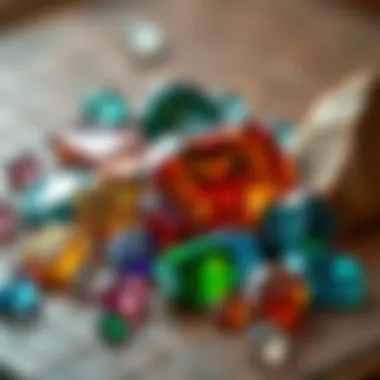

Global Market Insights
The sapphire market illustrates broad trends, with prices escalating over the past decade. Emerging markets, particularly in Asia, are contributing to demand, influencing availability and pricing dynamics. Those wishing to invest need to keep a sharp eye on trends and associated markets.
Tanzanite
Tanzanite is a fascinating addition to the list, prized for its unique appearance.
Unique Characteristics
What sets tanzanite apart is its distinct color-changing properties, often appearing blue, violet, or burgundy depending on the light source. This unique feature makes it a sought-after addition for jewelers and collectors alike. However, it challenges buyers to be discerning, as shades can sometimes be misleading in artificial lights.
Availability and Demand
Originating solely from Tanzania, tanzanite has a geographically limited supply. With demand increasing, the limited deposits signal a potential for price increases. Thus, buyers must be cautious yet optimistic, as future availability is uncertain.
Investment Factors
As tanzanite becomes more recognized, it has been attracting the attention of investors. Its combination of beauty and rarity positions it as a solid investment. Its fast-rising demand, paired with potential scarcity, indicates it could become one of the prized gems in the future.
Alexandrite
Alexandrite is undoubtedly one of the most mysterious and sought-after gemstones.
Color Change Phenomenon
Its famed color-change ability, switching from green in daylight to red under incandescent light, is extraordinary. This phenomenon not only makes it stunning but also adds great value, as it is rare to find such dramatic color shifts in nature.
Sources of Alexandrite
The best-quality alexandrites originate from Russia, Brazil, and Sri Lanka. Each source produces notable differences in coloration and quality. For collectors, knowing these sources allows for more informed decisions, as quality can drastically influence pricing.
Market Value Fluctuation
Warranty concerns, along with the limited availability, mean the market for alexandrite can oscillate. Thus, investments carry unique risks, compelling buyers to keep abreast of market dynamics and trends to time their purchases wisely.
Painite
Painite was once deemed the rarest mineral on Earth.
Discovery and Rarity
Discovered in Myanmar, Painite is rare enough that many collectors still hunt for this elusive gem. Its sheer scarcity enhances its desirability, with only a handful reportedly existing in private collections around the world.
Significance Among Collectors
Due to its rarity, painite has garnered the attention of serious collectors and investors. This exclusivity makes it especially valuable. An investment in painite represents not just an ownership of a gem, but a piece of geological history.
Current Pricing Trends
While priced astronomically, recent auctions have shown fluctuations, leading to potential trends in pricing. Collectors should consider these dynamics when purchasing, as prices may decrease or rise dramatically over time.
Black Opal
Black Opal is recognized for its captivating play-of-color.
Formation Process
Formed in sedimentary rock, black opals originate from silica gel deposits that have hardened under specific environmental conditions. Understanding the geological process can enhance collectors’ awareness and appreciation of the stone’s originating qualities.
Market Challenges
Navigating the opal market can be tricky; varying quality can often lead to confusion among buyers. With multiple sources and grading scales, buyers must be educated to avoid overpaying for what could be an inferior product.
Aesthetic Appeal
The visual allure of black opals is significant, attracting those who appreciate a gemstone that can display a stunning palette of colors. The aesthetic appeal often outweighs other factors, making them prized possessions in collections, though transparency about authenticity remains crucial.
In summary, the landscape of expensive gemstones is diverse and multifaceted. Whether it be diamonds with their historical context, emeralds with their rich colors, or the newfound allure of tanzanite, each gem tells its own story and offers unique investment potential. Understanding these elements is critical for any gem enthusiast, allowing informed choices in this captivating arena.
Understanding the Market for Gemstones
The market for gemstones has grown into a complex web of collectors, dealers, and investors, each with their own motivations and expertise. Understanding this market is crucial for anyone venturing into the realm of precious stones. It touches on various elements: how gemstones are valued, how they are bought and sold, and the broader social implications of their trade. Knowing how the market operates allows potential buyers to navigate it wisely. The nuances of pricing can be influenced by everything from fashion trends to shifts in consumer preferences. Familiarity with market mechanisms can empower buyers to make informed decisions—whether you're looking to invest, collect, or simply enjoy decorative pieces.
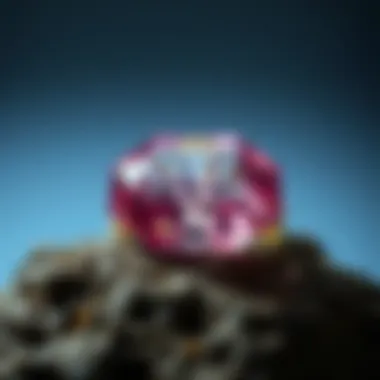
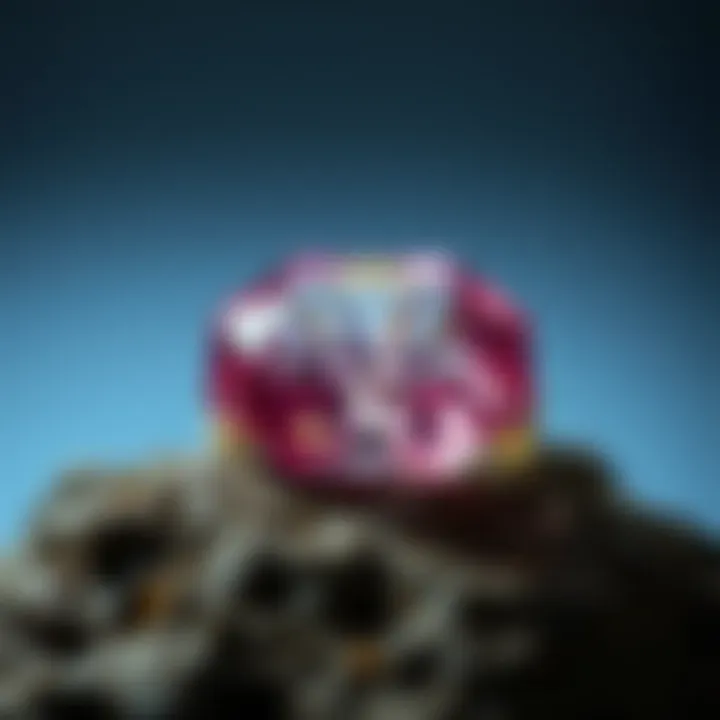
Auction Houses and Sales
Auction houses play a pivotal role in the gemstone market, serving as gatekeepers to the most coveted pieces. Renowned institutions like Sotheby’s and Christie’s often present rare stones that can fetch staggering prices. When a gemstone is put up for auction, several factors come into play.
- Provenance: Established history often adds to the gem's allure. A gemstone with a tale connecting it to royalty or celebrities can see its value skyrocket.
- Bidding Dynamics: Auctions can create a frenzy, with competitive bidders driving the price up quickly. Those with deep pockets have been known to walk away with gems that many consider a once-in-a-lifetime acquisition.
Individuals or investors often attend these events not merely for the purchase but to immerse themselves in the prestige of the gemstone world. Each auction tells a story, revealing shifts in trends and tastes. The excitement of live bidding pairs with the potential for high returns, making it a significant area to watch for enthusiasts.
Private Sales and Collectors
Private sales are often where the real gems—literally and metaphorically—lie. In this quieter corner of the gemstone market, collectors and dealers build relationships, often relying on trust and reputation rather than public spectacle. These transactions can be more discreet, and they afford buyers a chance to negotiate prices in a more controlled environment.
- Networking: The private world runs on connections. Buyers looking for specific gemstones must often network to gain access to private collections.
- Value Appraisals: When dealing privately, expertise is crucial. Collectors are advised to seek professional appraisals to ascertain the worth of potential acquisitions.
Collectors take pride in the stories behind their gemstones and often relish sharing their finds within their circles. Unlike auction houses that attract attention, private sales provide a quieter, more intimate space for appreciating these beautiful stones.
Online Platforms for Unique Gemstones
The rise of e-commerce has transformed gemstone buying, democratizing access to rare pieces that were once confined to brick-and-mortar establishments. Numerous online platforms cater specifically to gemstone enthusiasts and collectors. This shift has its pros and cons.
- Advantages:
- Challenges:
- Accessibility: Buyers can peruse a global selection without leaving their homes, exploring offerings from remote corners of the earth.
- Price Comparisons: Online shopping allows for quick comparisons, helping buyers understand the market's average pricing for similar stones.
- Authenticity: The online marketplace can host less-than-reputable sellers. Buyers need to vet sellers carefully and seek reliable reviews and certificates of authenticity.
- Invisible Touch: Without physically inspecting a gemstone, buyers may not grasp its true beauty and flaws, making due diligence all the more critical.
In a world increasingly defined by digital interactions, online platforms represent a game-changer, bridging gaps and connecting individuals willing to explore the intricacies of the gemstone market.
Understanding these elements of the gemstone market empowers buyers and collectors alike to navigate with confidence, ensuring that their investments are both sound and satisfying.
Ethical Considerations in Gemstone Trade
The gemstone trade is not just about sparkling stones and hefty price tags; it encompasses a web of social, environmental, and economic factors that can’t be ignored. As collectors and investors delve into the realm of precious gems, understanding the ethical implications of sourcing and trading these stones becomes crucial. The choices made within this industry can impact communities, ecosystems, and the very foundations of market value. An awareness of ethical considerations can enhance a collector's appreciation for their treasures while ensuring a positive influence on the world.
Sourcing Practices
Sourcing practices are at the heart of the gemstone trade, often prompting tough questions about morality and sustainability. Unscrupulous practices can lead to the exploitation of laborers and the destruction of local environments. For instance, artisanal mines employing child labor or exposing workers to unsafe conditions contribute to a cycle of poverty. Meanwhile, gems harvested unethically can flood the market, undermining the value of responsibly sourced stones.
To ensure that a gemstone is ethically sourced, collectors should seek transparency from dealers, which often includes:
- Traceability: Knowing the origin of a gemstone can help mitigate the risks associated with illegal mining practices.
- Fair Trade Organizations: Some sources are certified by organizations ensuring that they comply with ethical guidelines and support local labor standards.
- Conflict-Free Certifications: Many diamonds and other gems have certifications indicating that they were mined without funding conflicts or human rights abuses.
Impact of Mining on Communities
The communities that surround gemstone mining sites experience direct effects from the extraction of these resources. On one hand, there can be economic benefits, such as job creation and local business support. On the other hand, mining activities can lead to profound social and environmental challenges.
- Social Disruptions: An influx of workers can strain local resources and lead to issues such as housing shortages and increased crime rates.
- Environmental Degradation: Mining operations can decimate ecosystems, leading to soil erosion, water contamination, and loss of biodiversity. These impacts can devastate livelihoods that rely on agriculture or fishing.
- Health Risks: Workers and nearby residents may face health hazards due to exposure to toxic substances used in mining processes.
Promoting responsible mining practices and investing in communities can help strike a balance between economic growth and social responsibility.
Regulations and Certifications
To navigate the complex landscape of gemstone sourcing, regulations and certifications have been established both locally and globally.
- National Regulations: Many countries have their own laws governing mining practices, which may include health and safety standards and requirements for labor rights.
- International Standards: Organizations like the United Nations and the Responsible Jewelry Council set frameworks for ethical trading in gemstones to foster a more sustainable and fair market.
- Consumer Awareness: As consumers grow more conscientious, they can push for transparency and accountability within the gemstone industry, reinforcing regulations through their purchasing choices.
"The gemstone trade has the potential to either uplift communities or exploit them; it’s up to us as collectors to choose wisely."
By recognizing and advocating for ethical considerations in gemstone sourcing and trading, collectors can not only enhance their own experiences but also contribute to a more equitable and sustainable industry. Being informed and making conscious choices can ensure that the brilliance of these stones shines brighter than their price tags.
Ending: The Allure of the World’s Most Precious Gemstones
The allure of gemstones has endured through centuries, captivating not just enthusiasts but also investors and collectors. This intricate world invites us to ponder not just on their glamorous exteriors but on the rich tapestry of histories and economies woven around each piece. Each gemstone, whether it is a diamond with its dazzling sparkle or a rare painite reflecting its exquisite hues, holds stories that add to their desirability and, in turn, their value.
Future Trends in the Gemstone Market
Anticipating where the gemstone market is headed bolsters our understanding of these precious stones. A shift towards sustainably sourced gemstones is already in progress. Buyers today are increasingly demanding ethically and environmentally responsibly mined stones. As awareness grows, many gem houses are morphing their practices to include full disclosures on the origins of their stones.
Additionally, the growing influence of technology cannot be ignored. Blockchain might soon be at the forefront, acting as a safeguard against fraud and ensuring authenticity from mine to market. This will likely forge stronger connections among collectors and suppliers, driven by trust, making the acquisition of these precious items even more appealing. Collectors aren’t only looking for beauty; they are also interested in the integrity of what they purchase.
- Sustainable practices: The future of gemstones will heavily lean on sources that adhere to ethical standards.
- Technological advancements: Innovations such as blockchain for authenticity will redefine ownership.
- Market demographics: The younger generation is showing more interest, potentially reshaping demand.
The Evolution of Gemstone Valuation
To comprehend the present landscape, we must consider the evolution of gemstone valuation over time. From being mere ornaments worn by royalty to symbols of wealth, gemstones have transformed into investments that even astute financiers are seriously considering. Historical context plays a pivotal role in this transformation. Previously, gems were appraised based largely on the 4Cs—carat, cut, color, and clarity. While these aspects remain significant, there’s been a gradual shift towards considering the story behind the stone—the mining location, the socio-cultural background, and even celebrity ownership influence the valuation today.
The consequences of this change are profound. Additionally, as the market diversifies with the entrance of unique gemstones like tanzanite or painite, new parameters for valuation will keep coming to light.
- Historical significance: The value of gemstones isn’t just measured in weight or appearance anymore.
- Cultural impact: Stories behind stones can elevate their worth significantly.
- Diversity of offerings: A wider variety of gemstones means a more intricate web of valuation standards.
In closing, the realm of gemstones is as multifaceted as the stones themselves. This extensive exploration reveals not just the surfaces of these dazzling objects, but sheds light on their broader implications, their connections to humanity, and their evolving status in both personal and financial contexts.



